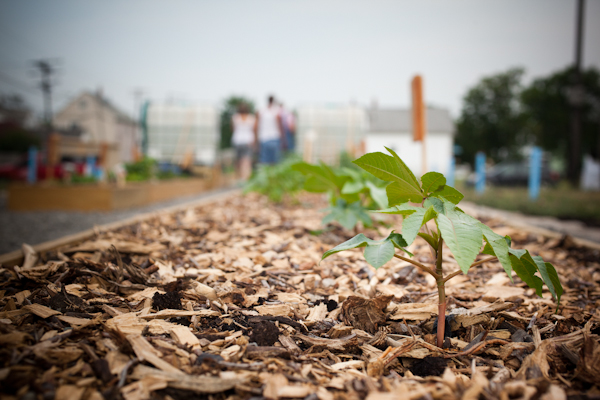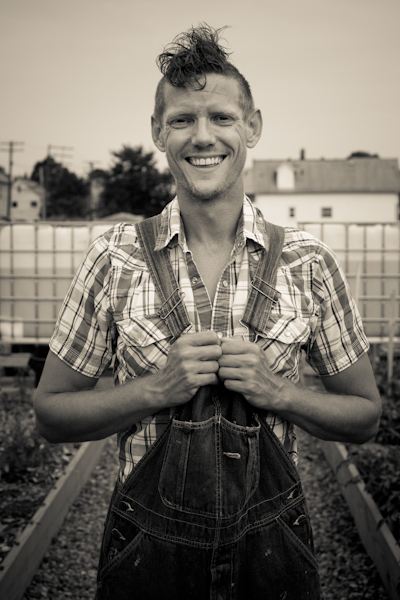Green City Diaries: This land is our land (Part 2)
Green projects are sprouting up all over the city. In part 2 his latest diary entry, Matthew Piper finds common ground in Hamtramck and Palmer Park.
Brad Dick, the director of Detroit’s General Services Department (which maintains parks, other greenspaces, and city facilities) told me that of the city’s 300 or so parks, it can currently afford to regularly maintain only 160. When the city announced the closure of 77 parks in 2010, the General Service Department’s maintenance staff had been reduced from 200 to 50 people, its full time staff from 50 to 20. (These are the staffing levels at which it remains, making attentive care to each city park impossible.)
Palmer Park, an historic, sprawling, 296 acre greenspace, was on that list. But in the wake of its official closure, a community of more than 70 supporters has coalesced around it, taking responsibility for its maintenance and programming themselves.
People for Palmer Park officially adopted the park under the city’s Adopt-a-Park program, which hands over maintenance responsibility (including waste disposal) to communities and individuals for a renewable term of one year. Dick explained that this 20-year old program significantly expanded after Mayor Bing began promoting it two years ago. Since that time, the number of parks in the city adopted by residents or community groups has grown from 25 to around 90.
People for Palmer Park also incorporated as a nonprofit conservancy organization in order to organize and fundraise (following in the footsteps of Clark Park in Southwest 20 years ago, and Belle Isle, more recently). Dick is working with a few other parks to adopt this model, which he sees as the best way forward for community-maintained greenspace in Detroit.
So far, the organization has cleared biking and hiking trails, organized architecture tours, weekly bike rides, community composting, and free yoga practices. They recently held a well-attended open house in the park’s historic log cabin, and they plan to hold harvest and art festivals in future seasons as well.
People for Palmer Park member Leonora King, who lives in Midtown but has been playing tennis in the park for 38 years, has contributed her talents by organizing weekly tennis lessons for children. (She was actually at a tournament there when she first learned of its impending closure.) At 35 kids, her classes are full to capacity, and she couldn’t be happier about it.
When she was a teenager, Leonora explained when we met at the courts a few weeks ago, she would take the bus from her home in the Dexter-Davison area to Palmer Park every day, often playing from 9 in the morning to midnight.
“The lights were working then, of course — we’re working on those. And there were more businesses around, more restaurants. The courts were so crowded, everyone would have to get a permit to play for one hour. I would cry if it rained.”
Leonora earned a tennis scholarship to Western Michigan University and has been playing in local tournaments since graduation. The goal of her work with kids at Palmer Park, and the work of her fellow players who maintain the courts, “is to get people to play tennis again,” she explained matter-of-factly. For Leonora, a healthy community starts with the literal physical health and camaraderie of its young people. She remembers her favorite sport as an important part of Black culture when she was growing up, and while one of the courts was full when I visited her at the park one recent evening, the others sat unused, a far cry from the bustling days she recalls.
I asked her why she chooses to participate in the resurrection of a public space noted in recent years for its decline. “We just have to take the initiative,” she answered. “If we want a better quality of life, we have to take part in making it better. I get so tired of people complaining, ‘The city won’t do this, the city can’t do that.’ I’m the city! You’re the city! It’s crazy that you wouldn’t think this is your space. Who is the city if you’re not the city?”
Meanwhile, in Hamtramck, Michael Davis recently decided to improve life on his block by turning several adjacent vacant lots into a paw-paw orchard. The paw-paw is a native Michigan tree that bears a fruit often described as being a cross between a banana and a mango (and sometimes called, among many other delightful names, a banango).
Michael didn’t have paw-paw trees in mind when he first started thinking about cultivating the land, which is literally a stone’s throw from his home. He’d been driving past the trash-strewn lots on Lumpkin Street, in the shadow of the American Axle Plant, for three years before he started daydreaming about turning them into something useful, beautiful, and beneficial to the community. “I originally thought about a giant pumpkin patch,” he said, “but that had a lot of naysayers.”
The idea gestated for several more years until a frustrated post he wrote in the Detroit Yes forums about the declining quality of his life in Hamtramck caught the attention of the city’s mayor, Karen Majewski. “She responded and said, ‘Can I come over for dessert and talk about what would keep you in Hamtramck?'” After their conversation, Michael had Majewski’s blessing and support for his use of the city-owned land, which had been vacant for almost 30 years, and was inspired to get started. When he tasted a paw-paw fruit grown by a friend’s father soon after, he knew what he wanted to grow.
Much of Hamtown Farms, as the orchard is known, was constructed and planted during a volunteer work day that drew more than 100 people last month. (Check out a great series of their portraits here.) It includes a total of 13 paw paw trees, which will eventually grow to about 15 feet tall. There are also eight pear trees, eight cherry trees, 30 hazelnut bushes, and several raised bed gardens for the neighborhood’s residents to use to grow vegetables.
Michael is amazed by the extent and depth of community support Hamtown Farms has received so far, and how quickly it’s turned into a neighborhood gathering spot. Kids on the block, as I observed first hand when I visited late one afternoon, will just wander over and start working, tending to their families’ plots and sweeping up the street. (They also demand to know when Michael is going to get to work on the half-sized soccer field he promised to make them across the street.) “When everyone had left after our volunteer work day, I took an hour break in the evening,” Michael said. “When I came back, there were kids out there spreading leftover gravel.”
“Now that they’re out of school,” his friend Julie Swartz added, “They’re out here for hours. We’re mobilizing them into little farmers.”
The kids’ parents, many of whom don’t speak English, have expressed thanks in other ways. One, an ice cream man, got of his truck, grabbed Michael, Julie, and their friend Jeff Taylor, and dragged them back to it, giving them all free treats.
The Hamtown Farms story is just one tantalizing glimpse of the neighborhood enriching potential that lies dormant in vacant city lots. (Another is Detroit’s picket fence program, through which residents of Southwest Detroit purchase neighboring vacant lots for just $200 and receive a $200 voucher to Brooks Lumber to buy picket fences to put around them. Brad Dick explained that the city is currently working on a plan to expand this program to other neighborhoods, so stay tuned for developments.)
The experience of bringing Hamtown Farms to life, meanwhile, has given Michael Davis a “newfound hope” in the city he’d found himself growing weary of. In just a few short months, the trash-strewn lots he so reviled have been remarkably transformed into a space that’s living, growing, and bringing the neighbors closer together.
While we were chatting in the orchard, one neighbor drove by in a pickup truck, leaned out her window, and shouted, simply, “THANK YOU!” Michael smiled and waved back to her. “That’s my reward. It’s already worth it.”
Matthew Piper is currently working on a piece on the sculpture/skate park under construction in the NoHam neighborhood.
Photos by Marvin Shaouni












